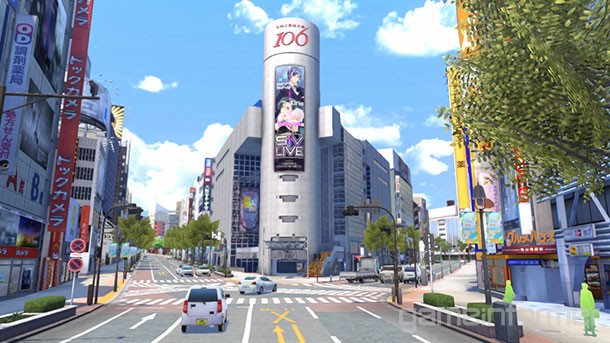Please support Game Informer. Print magazine subscriptions are less than $2 per issue
Tokyo Mirage Sessions #FE

Since the trailers have surfaced, most people haven't known what to make of this Shin Megami Tensei and Fire Emblem crossover. Both series are usually serious affairs, but Tokyo Mirage Sessions #FE is over the top, transforming vibrant characters into pop stars. It's an unexpected direction, but that's not a bad thing. I spent two hours with the game and loved its lightheartedness and how it has fun nods to both series. Here are my five biggest takeaways.

The Zany Premise Makes Things Fun
The story is centered on superstars mysteriously
disappearing and having their creative energy stolen. You play as blank-slate
protagonist Itsuki, and choose his responses for dialogue options, much like
the protagonists in the Persona series. To help set things right, you and your
friends must enter the Idolasphere, which transports you to an alternate
dimension, and use your talent on the battlefield to save the day. Every battle
is like a performance, with a crowd cheering you on in the background and the
brightly lit stage giving you the perfect arena to display your moves.
When you get into the Idolasphere, you meet up with Awakening's Chrom and Shadow Dragon's Caeda. This is when they fuse with your party members to lend your characters their powers. For instance, the main character fuses with Chrom, allowing him to learn some of his powerful sword attacks. You'll find more party members and their Fire Emblem counterparts along the way, and watching them fuse together delivers an awesome cutscene. As for why the Fire Emblem characters are along for the ride, that's also part of the mystery. At the very least, they're pulling their weight by lending you some of their skills.

An Intriguing Look At Japanese Popular Culture
Tokyo Mirage Sessions is set in present-day Tokyo and lets
you visit real-world locations like Shibuya and its famous Harajuku fashion
district. The game doesn't dial back on showcasing Japanese fashion trends and
its overzealous adoration for the entertainment field. Models, pop stars, and
actors are all put on a pedestal. In fact, one of your party members is an
actor, while the other is the ultimate celebrity fan girl. You home base is
even a talent agency, and you can send characters to do lessons in the studio
to improve some of their skills. Because the game is set in popular Tokyo
districts, expect to see everything from the Shibuya scramble crossing to
convenience stores accurately portraying the amount of delicacies you can get in a
jiffy in Japan. If you're a fan of Japan or have been dying to get a taste of
its popular culture, you'll enjoy Tokyo Mirage Sessions.

A Traditional Battle System With A New Wrinkle
As you explore, evil spirits called Mirages attack you; if
you strike them first, however, you can get the upper hand. The turn-based
battle system will be familiar to anyone who has played an SMT game; it's all
about exploiting elemental weaknesses, but it also taps into Fire Emblem with
weapon weaknesses and mastery levels allowing you to learn new skills. Sessions
are what make the battle system new and exciting. If you exploit an enemy
weakness and your party member has a session skill to match it, they follow up
with an attack for a devastating combo – it's like getting in an extra turn.
Sessions are essential to your success and super satisfying to land. You can
have three party members on the battlefield at once, but you can swap members
in and out during battle (except the main character, who always has to be in
your party). This is great for when you're in a jam with your health, or if you
have better characters suited to face particular enemies.

Themed Dungeons Keep Exploration Exciting
The dungeons are true to SMT with varied themes and uniquely
designed monsters to match them. During my time, I saw creative dungeons such
as one devoted to fashion, where I had to change mannequin poses to move a
massive dress that I could walk through to get me to other sections of the
dungeon. Another focused on modeling and had cameras located all around; if
I stepped in the camera's vicinity, I got transported to the beginning of the
dungeon, forcing me to find ways to get around them. Boss battles also
had fun twists, like giving you multiple enemies but tasking you with only
attacking the one with dark essence, forcing you to pay attention to visual
cues. You never know what you'll find or what crazy thing you'll have to do next
in a dungeon, which I enjoyed – especially when it came to the enemy designs. I
tackled everything from sinister clowns to hooded spectres.

It Leans More Toward SMT's Style Than Fire
Emblem's
Atlus developed the game, so it didn't surprise me that I
felt like the crossover leaned more to the SMT side, mainly in how the game is
structured, but I did spot Fire Emblem nods throughout my playtime. They're
just not as noticeable as the SMT ones, like seeing Jack Frost on the
convenience-store sign. The game plays heavily to what makes SMT fun, watching
creative and warped version of monsters and dungeon-crawling through unique
backdrops. The Fire Emblem references feel more behind-the-scenes and are put
more in display in the special weapon skills you get and crafting you do to
gain better weapons and skills. That being said, I only got to experience a small slice
of it, so I'm hoping the Fire Emblem characters have more of a role later as you start piecing together why
they're in this universe.
What do you think of Tokyo Mirage Sessions? Let us know in the comments below!











